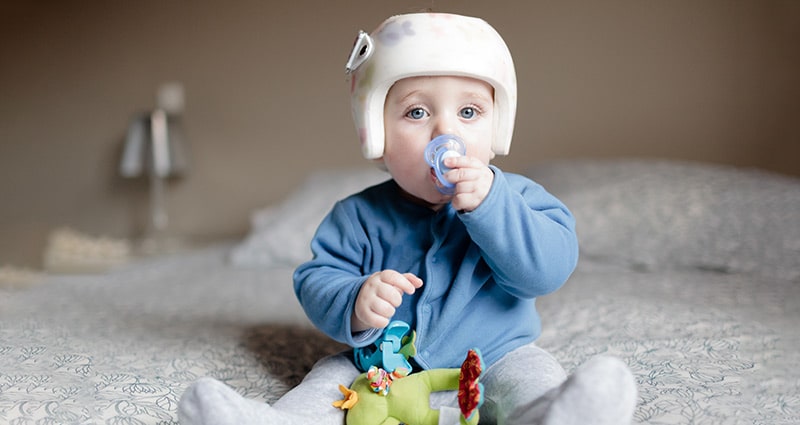What happens when your baby’s head doesn’t have a nice round shape?
Lisa Morris, MD, explains positional plagiocephaly, which means an abnormally shaped head, and how it can be prevented and treated.
Dr. Morris is a double Board Certified facial plastic and reconstructive surgeon who specializes in the reconstruction of children and adults with deformities of the face, head and neck. She is the co-director of Our Lady of the Lake Children’s Health Cleft and Craniofacial multidisciplinary team, which is nationally recognized and accredited by the American Cleft Palate-Craniofacial Association.
Infant Head Shapes
Babies have moldable heads because their skulls are not fully formed and hardened. This helps them to fit through the birth canal and is the reason they have soft spots. Within the first few weeks of birth, babies should have nice round heads.
If you notice a misshapen head, be sure to mention it to your pediatrician and they can help you determine your next steps. It’s never normal, and by around two weeks of age any “conehead” shape from birth should be resolved.
If there is stiffness in baby’s neck (torticollis), your pediatrician may recommend neck exercises, physical therapy or a visit with a specialist. Most abnormal head shapes are due to positioning.
Prevention – Adjust Baby’s Position
If babies lay too long on any one side—or their backs—the head can develop a flat spot. That’s not concerning other than the way it looks, and it may continue to be flat throughout the child’s life if not addressed. In general, there are no functional problems associated with having positional plagiocephaly, but there are ways to prevent it and correct it.
Alternate the direction baby is put down in the crib (feet closest to door one night, feet closer to window the next night). Babies naturally turn toward sounds, so this will encourage them to turn to the left one night and to the right the next night. It also helps to keep babies held upright part of the day. And don’t worry, you can’t spoil babies by holding them too much!
Safety first, head shape second. When babies are sleeping, they should always be placed on their backs, which is the safest position for sleep until age 1 to help prevent sudden infant death syndrome. Sometimes NICU babies may have a chest tube, cast or something else that prevents them from being regularly re-positioned.
The key concept is to make sure baby’s position changes and they aren’t constantly laying on the same part of their head. Dr. Morris likens this positioning to roasting a marshmallow. “You don’t want it raw on one side and burnt on the other.”
Although baby may protest, supervised tummy time is an important way to avoid head shape abnormalities. It also helps strengthen baby’s neck and other muscles.
Helmet Therapy
When a child is diagnosed with positional plagiocephaly and has not improved with repositioning, the current recommendation is to re-mold the head into a more normal shape using helmet therapy. The use of helmets to re-mold the skull is not a new treatment and has been used in some fashion for more than three decades.
Helmet therapy usually starts when the baby is about 5 to 6 months old. At that age, baby’s brain is growing very rapidly, and the helmet can produce rapid changes quickly. That rapid growth slows after age 1, although head shape can get better later, helmet therapy works best when it’s started around 5 to 6 months.
How Does Helmet Therapy Work?
An orthotist scans baby’s head and fabricates a helmet designed specifically for them, a process that takes about two weeks.
If helmet therapy is to work, the child will need to wear the helmet on a consistent basis, about 23 hours per day. The helmet may be removed for airing or bathing. Most children are able to tolerate the helmet within the first 24 hours.
Follow-up visits with the team happen every three to four weeks to gauge the progress of the helmet therapy and measure head circumference.
The usual time for helmet therapy averages three to four months. Although it may seem to be long it is quite short in a child’s lifetime considering the long-term effects of having an abnormal shape head.
More Serious Condition: Craniosynostosis
Occasionally, babies can have a serious condition called craniosynostosis that results from skull bones fusing together too soon. This type of problem would need surgery, which can easily be handled by Dr. Morris and her team at Our Lady of the Lake Children’s Hospital or Ann Marie Flannery, MD, pediatric neurosurgeon at Our Lady of Lourdes Women’s & Children’s Hospital in Acadiana.
The earlier it’s detected the better, so mention any concerns about head shape to your pediatrician. A minimally invasive endoscopic surgery is an option before 3 months, otherwise a larger reconstructive skull surgery would performed closer to a year of age.




